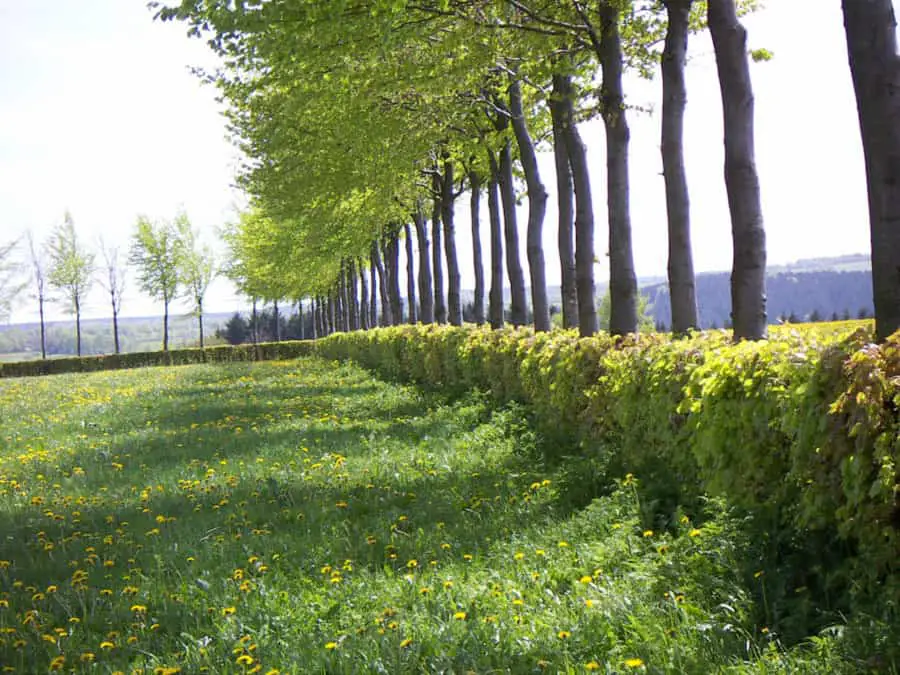Whether you want to decorate your backyard, set up a boundary for your property, or create an enclosure for cattle, a hedgerow fence can help you out. Growing hedges is the best technique to achieve various purposes in an environment-friendly manner. So, let’s discover the things you should keep in mind while growing a hedgerow fence and how you can make the most of it.
How to Create the Perfect Thick Hedge?
Hedges serve as boundary walls composed of shrubs and trees while also accentuating the beauty of that area. But this does not mean that you can plant any random kind of hedge and expect wonders from it. In fact, there are many factors that go into creating a thick hedge suitable for your needs and demands.
Keep reading to know how you can create the perfect thick hedge!
- Choose the Location
- Determining the Height and Width You Want
- Picking Plants for a Hedgerow
- Preparing the Soil and the Area
- Determine the Spacing of Hedge Plants
- Planting
- Trimming for Encouraging Thick Hedge Growth
- Maintaining the Hedge Row
- Benefits of Hedgerows
Choose the Location
The first thing to consider is the place for setting up a hedgerow fence. Hedges are mostly grown around the edges of a garden, driveways, lawn, and walkways. Other than this, hedges also look great as boundaries separating two areas. While choosing a location, make sure it is not a busy place, as high-traffic areas can affect the plant’s growth. It’s also important to ensure that the hedge does not block a path.
One more thing to note is the response and requirement of a plant for sunlight. Place hedges that need constant sunlight under the open sky and plant hedges that won’t die in the shade where partial sunlight is available.
Determining the Height and Width You Want
Some hedges grow very tall while some grow up to 4 feet to make a medium or small fence. Similarly, you can grow hedges in several different widths, ranging from 1 to 3 feet. From so many options, the best way to determine the perfect height and width is to consider the purpose of planting hedges.
5 to 8-feet high hedges are a good choice for creating a privacy border. This height bracket is also ideal for enhancing the driveway passage and marking a boundary between you and your neighbor’s house.
However, if you want to use the hedge as a border for your garden or porch area, go with 3 to 4-feet tall hedges. These medium-sized hedges don’t obstruct the view or wind but only give a refreshing vibe.
Similarly, small shrubs and hedges are most suitable for display purposes. By trimming a thick hedgerow in creative designs, shapes, and cuts, you can make gardens, driveways, pathways, and backyards look appealing.
To determine the width, first figure out whether you need a hedgerow for privacy a width of 3 feet or a bit wider.

Picking Plants for a Hedgerow
Various types of shrubs, and trees are used in a hedgerow fence. Usually, a hedgerow consists of a single species plant, but some gardeners create a unique fence using two types of plants, which adds to its beauty and purpose.
To simplify the selection of plants, consider your requirements and preferences again. If the main goal is to establish a boundary to restrict the entrance of intruders and outsiders, you should look for plants with some thorns. For this case, Hawthorns and Dog Rose are recommended. Both include a significant amount of thorns and thick branches that ensure safety. Plus, Dog Rose grows rose flowers that appear visually attractive as well.
Meanwhile, choose flowery hedges to add greenery and charm to a dull-looking place. Light and dark pink and white flowers, coupled with fresh green leaves, impart a mesmerizing view when bunched together in a hedgerow. Moreover, a hedgerow made from white, pink, red, and violet Rose of Sharon is also a sight to behold. These plants grow up to 8 to 12 feet in the air, meaning you can easily grow a tall hedgerow fence. You can also opt for Boxwood shrubs if you want a hedgerow enriched with greenery and broad leaves.
On the other hand, Cherry Laurel is one of the best options for taller hedges. They tend to grow to a height of up to 9 meters and are dense enough to bar winds and minimize pollution. Apart from this, you can consider field maple, which is also a tall and dense plant.
Preparing the Soil and the Area
To avail the benefits of a hedgerow, it is essential to provide it with the best soil conditions. For that, you have to make planting arrangements and start the preparations of the area and soil weeks before you plant the hedge.
If the location is a farm, the soil might already be fertile. Thus, you may not have to invest much time and effort into preparing the soil. Dig the ground and add fertilizers and pesticides to make the ground favorable for hedge growth.
For growing hedgerows next to lawns, gardens, driveways, or in places where you can’t expect a fertile ground, sheet mulching may be required. Using this technique, dig the ground and let fresh air enter the soil first. Remove weed and dead bushes from the land. Then, place biodegradable cardboard or grocery paper bags all over the surface until the ground is not visible. Spread a generous amount of organic matter or compost on the cardboard pieces. Leave this setup for a month or at least two weeks. After that, the soil will be ready for your hedgerow fence.
Determine the Spacing of Hedge Plants
Leaving ample space between consecutive rows of hedges is very important; this ensures that they receive sufficient nutrients and light. Also, if there is enough distance between two hedgerows, it would be easier for you to reach all plants for routine maintenance.
A gap of 60 to 100 cm is fine for planting medium hedgerows. Tall and dense hedges would need more space between neighboring rows to get adequate exposure to sunlight. Thus, it’s better to plant tall hedgerows 100 to 200 cm apart from each other.
Hedgerows used to create a pronounced border around your house should be planted well within the boundary of your property. Hence, when the shrubs grow bigger, they won’t end up disturbing your neighbor.

Planting
A hedgerow is planted using saplings. For this, dig a hole deep enough to house the roots of the plants. Then water the soil generously. After that, water the hold, making sure that only the roots are buried, not the plant.
In the case of root ball hedging, the hole you dig should be deeper and wider. The soil should be moist when you plant the root balls. After watering the roots, cover them with soil and some compost.
Before you get started with planting, make sure you have all the essential gardening tools. These include a watering can, shovel, fork, hand trowel, and rake. Also, it would be better for you to wear protective gear, such as gloves and kneeling pad.
Seasons also matter when it comes to planting a hedge. It’s better to grow evergreen hedges at the start of autumn, while late autumn is the best time to grow deciduous plants.
Trimming for Encouraging Thick Hedge Growth
Hedges need trimming to grow thick, dense, and fast. The thickness of hedges also depends on how much you trim them. Try not to trim a hedge more than 20-25% of the total volume. Over-trimming results in permanent damage to the plant. While trimming, keep the base broad and the topmost portion a bit slim. This way, the root will get better access to water and sunlight for better growth. You can also use a hedge shears or hedge trimmer to trim delicate shrubs with perfection. Trimming also keeps the growth of lateral branches in progress, thereby retaining the density of hedgerow.
Along with ensuring healthy growth, trimming also gives plants a neat look. Trimming hedgerows in intricate designs and dimensions add to the aesthetics of the landscape.
Maintaining the Hedge Row
Having a fully grown hedgerow doesn’t mean your job is done. Once the shrubs grow to the desired height, it’s your duty to maintain it at regular intervals. The maintenance includes inspecting the condition of soil and shrubs, looking for any dead branches and overgrown shrubs, and watering the plants. Use eco-friendly pesticides if your plants are infested by pests. Be consistent in periodic trimming sessions of the hedges. Also, be careful in the selection of proper hedge shears, and using the right techniques.
If you take good care of your hedges, you will surely get an elegant background, clean environment, and pleasant fragrance.
Benefits of Hedgerows
Hedgerows are mostly presumed to be a source of beauty used for decorating gardens, pathways, driveways, porch, etc., which is very true. Flowery hedges look eye-catching wherever they grow. But hedges have much more to offer.
Strong winds cause soil erosion when they blow the soil favorable to your plant away. All these situations make wind barriers a necessity.
Thus, if you grow a thick hedgerow on the border of your farm, you can protect your crops from relentless winds. Winds can also severely impact pollination and reduce growth in your garden, but with thick, dense hedgerows, you won’t have to worry about that.
Moreover, dense hedges help cut down noise pollution to a significant extent by absorbing sound waves. Thus, by growing a hedgerow fence, you can enjoy a privacy screen and a noise filter as well.
Lastly, a hedgerow fence also serves as a shelter for birds and insects.
Conclusion
Want to style your lawn or protect your harvest? Grow your favorite plants in the form of hedges around your property and make your outdoor space pleasant-looking, calm and secure. If you doesn’t have the time for growing the perfect hedge, a great alternative to these are artificial hedge walls that look no different from live hedges and demand minimal maintenance. Also, artificial hedges incur no damage because of pests and insects.


